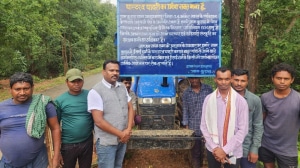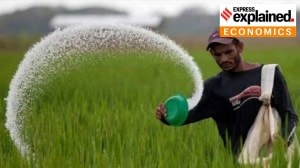Shubhajit Roy, Diplomatic Editor at The Indian Express, has been a journalist for more than 25 years now. Roy joined The Indian Express in October 2003 and has been reporting on foreign affairs for more than 17 years now. Based in Delhi, he has also led the National government and political bureau at The Indian Express in Delhi — a team of reporters who cover the national government and politics for the newspaper. He has got the Ramnath Goenka Journalism award for Excellence in Journalism ‘2016. He got this award for his coverage of the Holey Bakery attack in Dhaka and its aftermath. He also got the IIMCAA Award for the Journalist of the Year, 2022, (Jury’s special mention) for his coverage of the fall of Kabul in August 2021 — he was one of the few Indian journalists in Kabul and the only mainstream newspaper to have covered the Taliban’s capture of power in mid-August, 2021. ... Read More
As Bangladesh PM Sheikh Hasina arrives, taking stock of India-Bangladesh ties: the achievements and the irritants
Bangladesh Prime Minister Sheikh Hasina arrived in New Delhi on a four-day visit to India on Monday. How has India's relationship with Bangladesh evolved over the years? What are the recent irritants in the bilateral relationship?
 Prime Minister of Bangladesh Sheikh Hasina being received by Minister of State Darshana Jardosh upon her arrival at AFS Palam, in New Delhi, September 5, 2022. (PTI)
Prime Minister of Bangladesh Sheikh Hasina being received by Minister of State Darshana Jardosh upon her arrival at AFS Palam, in New Delhi, September 5, 2022. (PTI)As Bangladesh’s Prime Minister Sheikh Hasina arrived in New Delhi on a four-day visit to India on Monday (September 5), the long-standing, unresolved dispute over the sharing of the waters of the Teesta is back in the news.
The issue of water-sharing remains a key irritant in the bilateral relationship that has otherwise been strengthened significantly under the leadership of Prime Minister Hasina and her Indian counterpart, Prime Minister Narendra Modi.
So, what is the status of the Teesta dispute?
The 400-odd-km-long Teesta rises in the Pauhunri mountain and flows through Sikkim and West Bengal before entering Bangladesh near Mekliganj, downstream of Jalpaiguri.
The Teesta, which joins the Brahmaputra in Bangladesh, carries a significant volume of water; it is the second largest river of West Bengal after the Ganga. India and Bangladesh have been in negotiations to determine the share of each country in the waters of the river since the early 1980s.
The two countries had reached a water-sharing agreement in 2011, and Prime Minister Manmohan Singh was about to sign the deal on what was billed as a historic visit to Bangladesh in September that year. However, West Bengal Chief Minister Mamata Banerjee, who was supposed to accompany the Prime Minister, objected at the last moment, pulling out the visit, and the deal was scuttled.
Prime Minister Narendra Modi visited Dhaka in June 2015. He was accompanied by Mamata, and he told Prime Minister Hasina that he was confident of a “fair solution” to the dispute through cooperation between the central and the state governments.
Seven years later, the Teesta issue remains unresolved. In an interview to ANI before leaving for New Delhi, Prime Minister Hasina said “India should show more broadness” on the issue. “…I think it should be solved but yes, we found that the Prime Minister is very…eager to solve this problem, but the problem is in your country… But it depends on…mainly on India,” she said.
Teesta aside, how has the relationship with Bangladesh evolved over the years?
India has a robust relationship with Bangladesh, which it has carefully cultivated especially since Prime Minister Hasina came to power in 2009. Over this period, India has benefited greatly from the security relationship with Bangladesh, and the Hasina government’s crackdown against anti-India outfits, which has helped New Delhi maintain peace and security in India’s eastern and Northeastern states.
Bangladesh too has benefited from its economic and development partnership with India. It is India’s biggest trade partner in South Asia, and bilateral trade has grown steadily over the last decade: Bangladesh’s exports to India has gone from only $304.63 million in 2009-10 to $1.28 billion in 2020-21, while its imports from India during this same period have risen from $2.3 billion to $8.6 billion.
India grants some 15-20 lakh visas every year to Bangladeshi nationals who visit for medical treatment, tourism, work, and entertainment. It is fairly common for Bangladeshi elite to make a weekend shopping trip to India — a group of Bangladesh nationals famously came in chartered aircraft to watch the film ‘Bahubali’ in Kolkata.
For India, Bangladesh has been a key partner in the neighbourhood first policy — and possibly the only success story in bilateral ties among its neighbours.
And what are the recent irritants in the bilateral relationship?
The proposed countrywide National Register of Citizens (NRC) and the Citizenship Amendment Act (CAA) created some rough edges in the relationship. Bangladesh cancelled visits by ministers, and Prime Minister Hasina expressed some reservations about CAA — saying that while the CAA and the proposed nationwide NRC are “internal matters” of India, the CAA move was “not necessary”.
Subsequently, then Foreign Secretary Harsh Vardhan Shringla, who had been a former Indian envoy to Bangladesh, travelled to Dhaka twice to assuage these concerns.
Photos



- 01
- 02
- 03
- 04
- 05




































